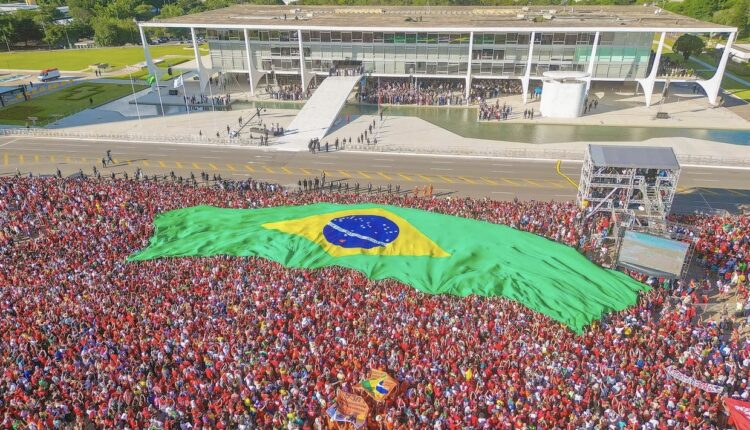
100 days of Lula’s presidency: What has changed in Brazil since January 1?
From Brasil de Fato
The administration of Brazilian president Luiz Inácio Lula da Silva of the Workers’ Party of Brazil (PT) completed its first 100 days this past April 10. Traditionally, this is the milestone in which a first assessment of the new presidential administration in the country is made, with the presentation of new measures to be adopted.
Brasil de Fato spoke to specialists and representatives of people’s movements to find out how these first 100 days are being evaluated. Check out the highlights:
Defense of democracy
Vera Chaia, Professor of Politics at the Pontifical Catholic University of São Paulo (PUC-SP), highlighted the importance of the actions of Flávio Dino (Ministry of Justice) in the face of the January 8 terrorist attacks.
“In the beginning, Flávio Dino stood out the most, due to the need to reverse this process and bring peace to Brazilian politics, with an impressive arrest of Bolsonaro’s terrorist supporters on January 8. Dino and Lula’s performance in the resistance was important in Brasília,” explains Chaia.
Economy
Fernando Haddad, in his role as head of the Ministry of Finance, has played an essential role in the construction and presentation of budget. “He has dealt with the most sensitive area, which is the economy, and the whole proposal of his ministry to improve the Brazilian economy, bringing another political dynamic to our economy,” Chaia commented.
For political scientist Mayra Goulart, the highlights were “the presentation of the budget plan and the defense of an economy that prioritizes social policies and social development.” She also points out that Haddad and Simone Tebet, who heads the Brazilian Ministry of Planning, “positioned themselves strongly, but without an open confrontation with the market.”
People’s movements
People’s movements told Brasil de Fato that for the first time since 2016, when Michel Temer assumed power after the coup against Dilma Rousseff, there is an open dialogue with the federal government and the possibility of taking demands to Brasília.
The central demands include the regularization of Indigenous lands and quilombola lands, as well as the regularization of settlements for agrarian reform. On March 21, the government granted land titles to three quilombola communities. So far, no settlements have been regularized nor have Indigenous lands been demarcated.
In the view of Iury Paulino, from the national coordination of the Movement of People Affected by Dams (MAB), the challenge for the movements “is to defend the government from fascist attacks, but, at the same time, press for the advancement of people-focused agendas.” For Paulino, and on a more emergency basis, the government will have to take a position regarding the renewal of licenses such as that of the Belo Monte Hydroelectric Power Plant, whose construction expelled 55,000 people from their land and whose operation dries up the water for 130 kilometers of the Volta Grande do Xingu, in the Amazon.
“The recognition of our lands,” emphasizes Val Eloy Terena, coordinator of the Brazil’s Indigenous People Articulation (APIB), is “the main demand of the movement,” because “without territory, there is no way to discuss agendas such as health, education, politics for women, children and youth.”
For Dinaman Tuxá, APIB’s executive coordinator, “in practice, the government’s most incisive action was the task force to combat mining in the Yanomami Indigenous land. We are also seeing the creation of dialogue to contain the most tense spaces, such as the creation of crisis offices for conflict areas.”
With regards to agrarian reform, the Landless Rural Workers’ Movement (MST) emphasizes that it believes it is necessary to structure the National Institute for Colonization and Agrarian Reform (INCRA) and for the definitive settlement of 65,000 families who live in camps.
“INCRA is like Funai (National Indigenous Peoples Foundation) of the landless people in Brazil. It is the authority responsible for inspecting, classifying properties, contacting the owner, negotiating, acquiring, updating registrations,” explains José Damasceno, from the MST’s national board.
Environment
The “zero deforestation” policy was one of the main campaign promises, in contrast to the environmental devastation left by Jair Bolsonaro. As president, Lula has implemented vital measures for the preservation of biomes, but he still has not definitively reversed the destructive actions in the Amazon and the Cerrado. And experts predict that it is a much longer process.
Environmentalists that spoke to Brasil de Fato are confident that the results should appear in the upcoming years, as long as there is stricter inspection and fewer concessions to agribusiness.
Ane Alencar, Director of Science at the Amazon Environmental Research Institute and coordinator of the Cerrado and Fogo biomes at MapBiomas, says that data from the Real Time Deforestation Detection System (Deter) indicate a significant reduction in deforestation up to March 24: in the Amazon it went from 941 km² to 710 km² and, in the Cerrado, from 1288 km² to 1244 km².
“It is already something to celebrate, especially in the case of the Amazon. But we need to consolidate this reduction. And this consolidation will happen as the government becomes more structured and organized,” says the MapBiomas member.
The Brazilian Environmental Governance Observatory (OGAM), created in 2022, calls on the Lula government to expand civil society participation in the National Environmental Council (Conama). The organization is the most important for dialogue between the federal government and civil society, but it had been emptied by Bolsonaro.

